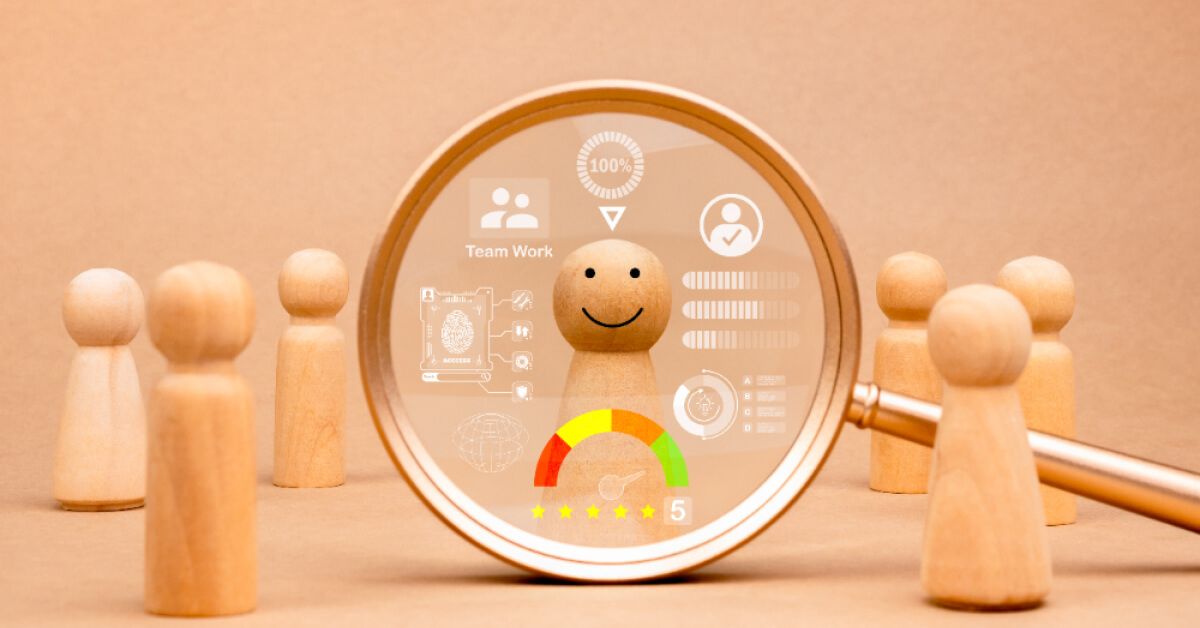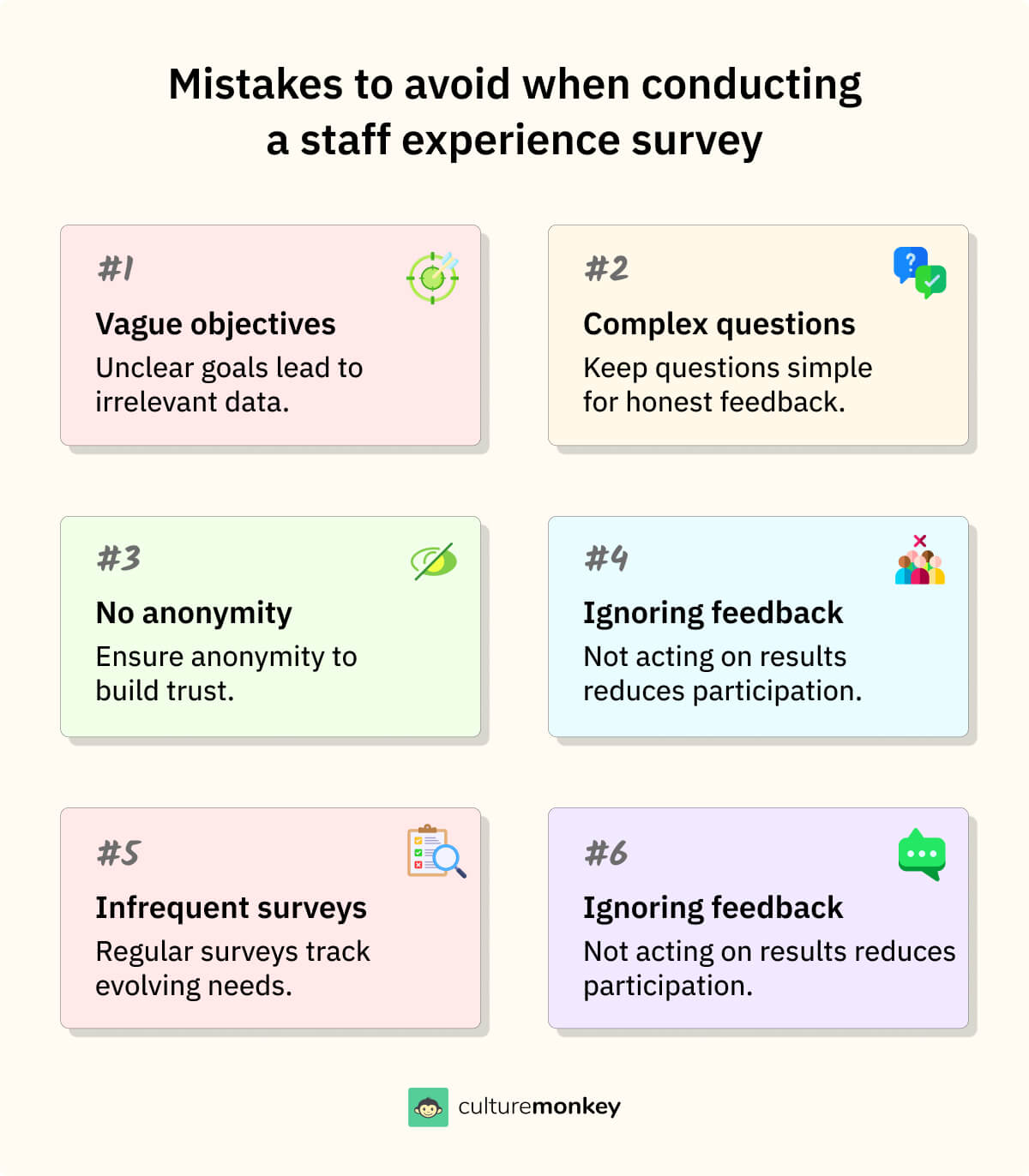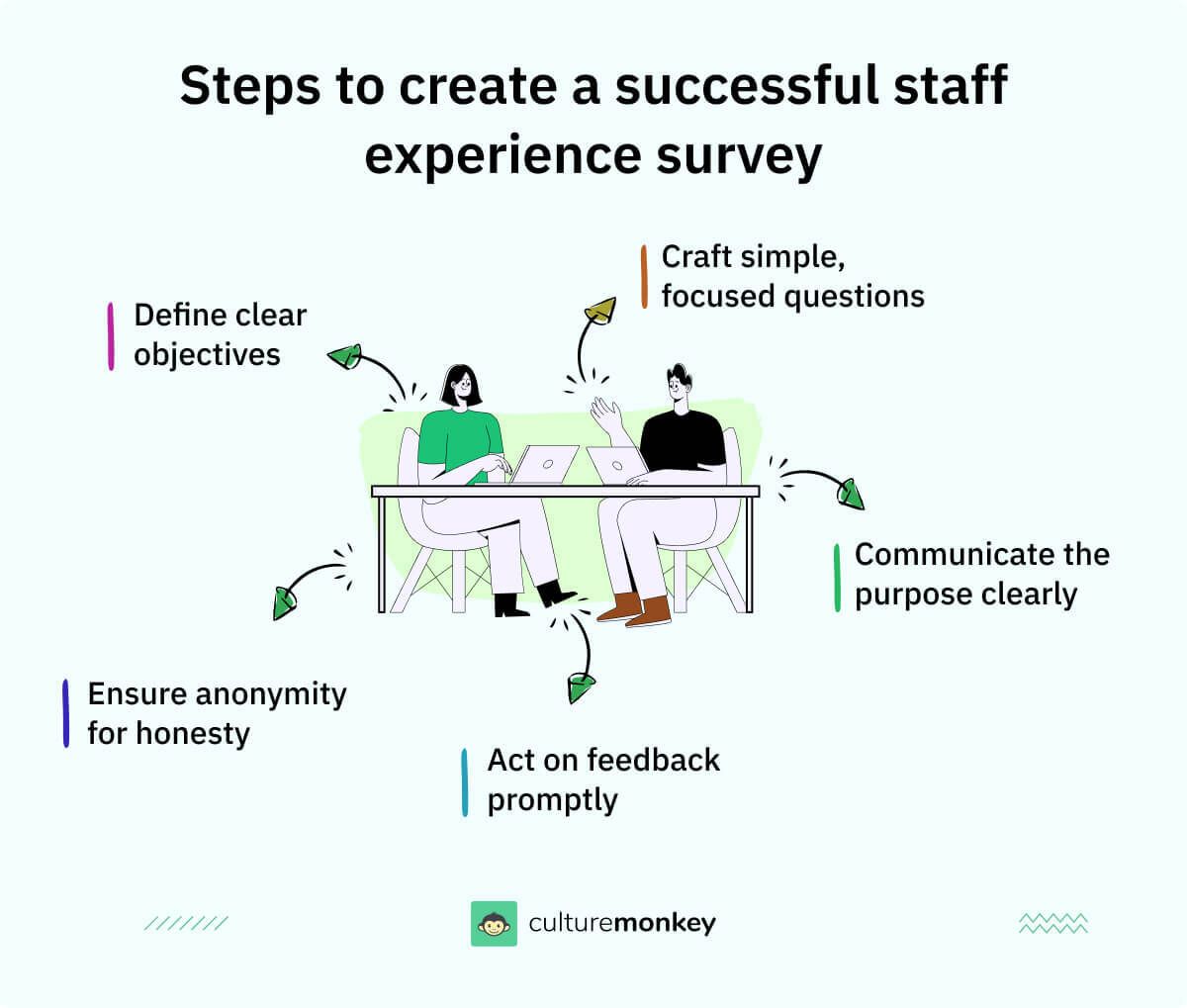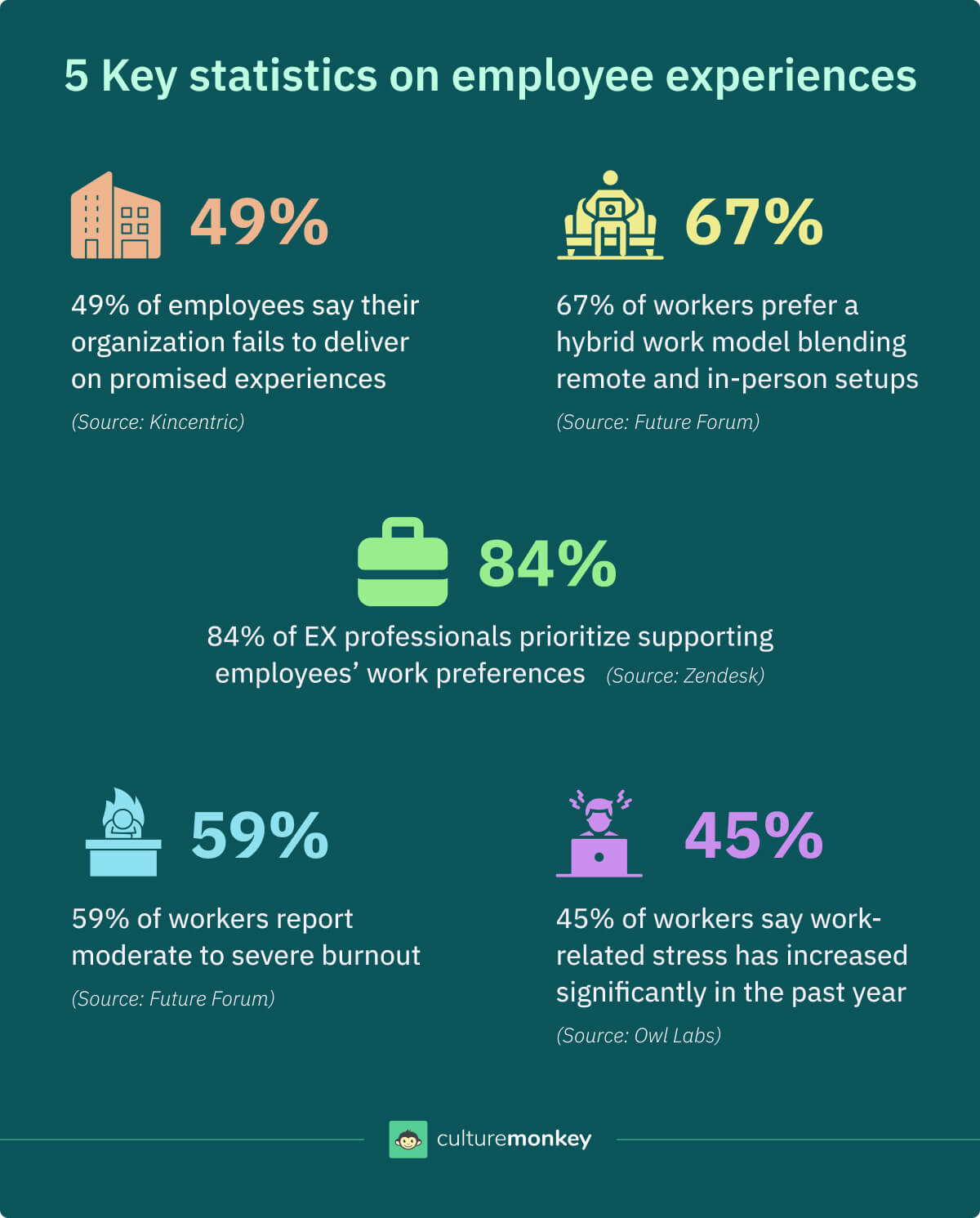What is employee experience survey: Best practices & survey questions

Imagine this: In 2008, Google decided to run an experiment called “Project Oxygen.” The goal? To understand what made managers effective. It wasn’t just about profits or performance metrics—it was about people.
They surveyed staff, analyzed the feedback, and found something game-changing: the best managers weren’t the ones barking orders but those who genuinely listened to their teams. This single revelation reshaped how Google managed its workforce, and it all started with one thing: asking the right questions.
That’s exactly what a staff experience survey is all about. It’s your golden ticket to understanding what your employees need, what’s working, and what’s not. Ready to discover how listening can transform your workplace culture and boost productivity? Let’s break it down.
Blog Highlights


What is an employee experience survey?

An employee experience survey is a systematic process of gathering feedback and insights from employees about their overall experience within an organization. It involves a series of structured questions that touch upon various aspects such as job satisfaction, work environment, leadership, communication, career growth and opportunities, and more.
These surveys aim to measure employee satisfaction and engagement, identify areas of improvement, and ultimately enhance the overall employee experience.



Before you become a leader, success is all about growing yourself. After you become a leader, success is about growing others.
CEO
General Electric
Benefits of employee experience surveys

- Insight into employee engagement: Employee experience and engagement surveys provide valuable insights into the level of engagement among employees. By measuring factors like job satisfaction, employee motivation, and commitment, organizations can identify areas where employees feel most engaged and areas that need improvement.
- Increased employee satisfaction: By giving employees a platform to voice their opinions and concerns, organizations can address issues that may be hindering their satisfaction. Addressing these concerns can lead to increased overall employee satisfaction, which in turn positively impacts the employee morale, productivity, loyalty, and retention rates of younger employees.
- Identification of areas for improvement: Employee experience surveys act as a diagnostic tool, helping organizations identify specific areas that need improvement. Whether it's communication channels, leadership effectiveness, training programs, or work-life balance, these surveys pinpoint areas that require attention and allow organizations to implement targeted strategies.
- Enhanced employee retention: A positive employee experience is crucial for retaining top talent. By understanding the factors that contribute to employee satisfaction and engagement, organizations can implement initiatives and changes that foster a positive work environment, and employee wellbeing and leading to higher employee retention rates.
- Alignment with organizational goals: Employee experience surveys provide an opportunity to align employee goals with organizational goals. By understanding individual aspirations and career development needs, organizations can create pathways for growth and development that align with the overall strategic objectives.
Challenges in running a staff experience survey
Conducting a staff experience survey is a powerful tool for understanding employee sentiment, but it comes with its own set of challenges. Identifying and addressing these obstacles is key to ensuring accurate, actionable, and meaningful results.
- Low participation rates: Despite the importance of feedback, employees may hesitate to participate due to survey fatigue or skepticism about whether their input will lead to changes. This lack of engagement can skew results, limiting their reliability and impact.
- Ambiguous or irrelevant questions: Surveys that include poorly designed, unclear, or overly generic questions can confuse respondents and fail to capture specific insights. Tailoring questions to your organization’s unique context is crucial to obtaining useful feedback.

- Overemphasis on quantitative data: While numerical scores are valuable, focusing solely on metrics can overlook nuanced employee experiences. Open-ended questions and qualitative data provide deeper insights into underlying issues.
- Delayed or insufficient follow-up: If survey results are not promptly analyzed or shared, employees may feel their feedback is ignored, leading to disengagement. An effective process includes swift analysis and transparent communication about next steps.
- Lack of managerial buy-in: Without support from leadership, implementing meaningful changes based on survey feedback becomes difficult. Managers play a critical role in fostering trust and ensuring surveys drive actionable outcomes.
- Cultural and demographic blind spots: Ignoring cultural differences or diverse employee needs in survey design can lead to biased or incomplete data. Ensuring inclusivity in language and topics ensures all voices are heard.
Are employee experience surveys anonymous?

Yes, employee experience surveys can be conducted anonymously to encourage more honest feedback, and unbiased feedback. Anonymity allows employees to freely express their thoughts, concerns, and suggestions without fear of reprisal or judgment.
This anonymity fosters a safe environment for employees to share their experiences and enables organizations to gather more accurate and insightful data.
However, it is important to note that some surveys may offer the option for employees to provide their feedback non-anonymously, allowing for further discussions or follow-ups if desired.
How to create an employee experience model?

- Define the purpose: Start by clarifying the purpose of your employee experience model. Determine what you want to achieve with the model and how it aligns with your organization's goals. This will serve as the foundation for building the model.
- Identify key factors: Identify the key factors that contribute to a positive employee experience in your organization. This can include aspects such as: company culture itself, leadership, communication, career development, work-life balance, recognition, and more.
- Conduct research and gather data: Collect relevant data and insights from various sources such as employee surveys, focus groups, interviews, and existing organizational data. This will provide a comprehensive understanding of the current employee experience and help identify areas for improvement.
- Define indicators and metrics: Determine the indicators and metrics that will be used to measure the employee experience. These could include employee engagement scores, turnover rates, productivity levels, employee satisfaction survey, or any other relevant metrics specific to your organization.
- Develop the model framework: Create a framework that outlines the key elements of the employee experience model. This framework should include the identified factors, their interdependencies, and their impact on the overall employee experience.
- Map the employee journey: Map out the employee lifecycle journey from pre-hire to post-employment. Identify touchpoints and interactions that employees have with the organization at different stages of their employment. This will help identify critical moments that influence the employee experience.
- Align with organizational values: Ensure that the employee experience model aligns with the core values and mission of your organization. The model should reflect and reinforce the desired organizational culture.
- Implement action plans: Based on the insights gathered and the identified areas for improvement, develop action plans to enhance the employee experience. These plans should include specific initiatives, programs, and policies that address the identified gaps and promote a positive employee experience.
- Communicate and engage: Transparently communicate the employee experience model to all employees, ensuring they understand its purpose and their role in shaping the employee experience initiatives. Encourage employee engagement and involvement in the ongoing improvement of the employee experience.

30+ Employee experience survey questions you should ask in 2025
- How satisfied are you with your overall experience at our organization?
- How would you rate the clarity of your job responsibilities and expectations?
- Do you feel recognized and appreciated for your contributions at work?
- Are you provided with opportunities for professional growth and development?
- How effective is the communication between employees and their supervisors/managers?
- Do you feel valued and supported by your immediate supervisor/manager?
- Are you satisfied with the work-life balance in our organization?
- How well does the organization promote diversity, equity, and inclusion?
- How satisfied are you with the physical work environment (office, facilities, etc.)?
- Do you feel encouraged to provide suggestions and feedback on improving processes or work-related matters?
- How frequently do you receive constructive feedback on your performance?
- Are you satisfied with the benefits and perks offered by the organization?
- How would you rate the opportunities for collaboration and teamwork within the organization?
- Do you feel aligned with the organization's mission, values, and goals?
- Are you given opportunities to take on new challenges and responsibilities?
- How effective is the organization in managing and implementing changes?
- Are you satisfied with the level of autonomy and decision-making authority in your role?
- How well does the organization support your mental and emotional well-being?
- Do you feel that your work is meaningful and contributes to the organization's success?
- Are there clear opportunities for advancement and career progression within the organization?
- How well does the organization recognize and address work-related stress or burnout?
- How satisfied are you with the performance evaluation and goal-setting processes?
- Would you recommend our organization as a great place to work?
- How satisfied are you with the onboarding process when you joined the organization?
- Do you feel that your input and ideas are taken into account during decision-making processes?
- How accessible and helpful are the HR and support teams when you need assistance?
- Are the tools and resources provided by the organization sufficient for you to perform your job effectively?
- How would you rate the organization's efforts in fostering a sense of community and teamwork?
- Do you feel your workload is manageable and evenly distributed within your team?
- Are there adequate opportunities for cross-departmental collaboration and learning?
- How effective are the organization's initiatives for promoting health and wellness programs?
- Do you believe the organization is transparent in sharing information about its performance and goals?
- How satisfied are you with the organization’s commitment to sustainability and social responsibility?

Build experiences
that engage
Take the first step—start your staff experience survey today and see the difference it makes.
Top employee experience survey metrics to track

- Employee satisfaction score: Measures overall employee satisfaction with their experience in the organization. This score highlights how well the company meets employees' expectations and needs in various aspects of their roles.
- Employee engagement score: Assesses the level of employee engagement and their commitment to the organization. High engagement scores indicate motivated employees who are emotionally invested in their work.
- Net promoter score (NPS): Indicates the likelihood of employees recommending the organization as a great place to work. A high NPS reflects strong employer branding and positive workplace culture.
- Employee turnover rate: The percentage of employees leaving the organization within a specific timeframe. Tracking this metric helps identify potential areas of dissatisfaction or gaps in employee retention strategies.
- Employee retention rate: The percentage of employees who remain with the organization over a given period. High retention rates suggest effective retention policies and a supportive work environment.
- Employee productivity: Measures the overall output, morale, and efficiency of employees. High productivity levels indicate alignment between employee efforts and organizational goals.
- Employee satisfaction with communication: Assesses employees' perceptions of the organization's communication practices. Effective communication fosters trust and clarity across teams and leadership.
- Employee satisfaction with leadership: Measures how employees perceive the effectiveness and supportiveness of leadership. Positive scores reflect confidence in leadership's ability to inspire and guide the workforce.
- Employee satisfaction with work-life balance: Assesses employees' ability to maintain a healthy balance between work and personal life. Organizations with high scores often enjoy better morale and lower burnout rates.
- Employee feedback scores: Tracks whether employees feel their feedback is valued and acted upon. High scores indicate a culture of openness and responsiveness within the organization.
- Employee recognition and reward scores: Assesses satisfaction with the recognition and rewards programs in place. Strong scores show that employees feel appreciated and acknowledged for their contributions.
Employee experience surveys best practices
Employee experience surveys are invaluable tools for understanding and improving workplace satisfaction. To maximize their effectiveness, organizations must follow certain best practices that go beyond the basics and ensure comprehensive, actionable insights.
- Define clear objectives: Start by identifying the specific goals of the survey. Whether it's to improve retention, enhance communication, or assess leadership effectiveness, clear objectives help design focused questions and streamline the analysis process.
- Pilot test the survey: Before rolling it out to the entire organization, conduct a pilot test with a small group of employees. This helps identify ambiguous questions, technical issues, or other obstacles that may impact participation or accuracy.

- Provide a time-effective format: Ensure the survey is concise and easy to complete within 10–15 minutes. Lengthy surveys risk disengagement and incomplete responses, which can reduce data quality.
- Use a mix of question types: Incorporate a combination of scaled, multiple-choice, and open-ended questions to capture a balance of quantitative and qualitative feedback. This approach yields richer insights into employee sentiments and concerns.
- Communicate a feedback loop: Regularly update employees about survey findings and the actions being taken. A transparent feedback loop demonstrates that their input is valued, building trust and encouraging future participation.
- Ensure survey accessibility: Make the survey accessible across devices, including mobile phones. This flexibility ensures higher participation rates, particularly among remote or field employees.
How to make the best use of your employee experience survey results?

Once you have conducted an employee experience survey, it's crucial to make the best use of the survey results to drive positive changes and improvements. Here's how:
- Analyze the data: Thoroughly review and analyze the survey data to identify key trends, patterns, and areas of concern. Look for both qualitative and quantitative data and qualitative insights to gain a comprehensive understanding of the employee experience.
- Identify priority areas: Based on the survey results, prioritize the areas that require immediate attention. Focus on the aspects that have the most significant impact on employee satisfaction, employee engagement efforts, and overall experience.
- Share the findings: Communicate the survey findings with relevant stakeholders, including senior management, department heads, and HR teams. Present the data in a clear and concise manner, highlighting the key takeaways and areas for improvement.
- Seek employee input: Involve employees in the process by sharing the survey results with them. Encourage open discussions and feedback sessions to gain further insights and gather suggestions for addressing the identified issues.
- Communicate progress and initiatives: Keep employees informed about the progress of the action plans and initiatives taken based on the survey results. Regularly update them on the steps being taken to address their feedback and concerns.
- Measure progress over time: Conduct regular follow-up surveys to track progress and measure the impact of the implemented changes. Compare the results of regular satisfaction surveys to the baseline data to determine if improvements have been made and identify any new areas of focus.
Why should you use an employee experience software to run surveys?

Using employee experience software to run surveys can offer numerous benefits, including:
- Efficiency: Employee experience software automates the employee engagement survey process, making it more efficient and saving time for both administrators and participants. It streamlines survey distribution, data collection, and analysis, eliminating the need for manual processes.
- Customization: Employee experience software allows you to create customized surveys tailored to your organization's specific needs. You can design surveys with relevant questions and response formats that align with your goals and objectives.
- Confidentiality and anonymity: Employee experience software ensures the confidentiality and anonymity of employee survey responses. It provides a secure platform for employees to share their feedback without fear of repercussions, promoting honest and candid responses.
- Real-time data analysis: Employee experience software offers real-time data analysis capabilities, providing instant access to survey results. This allows you to quickly identify trends and patterns, enabling timely decision-making and action planning.
- Reporting and visualization: Employee experience software generates comprehensive reports and visualizations, simplifying the interpretation of survey data. It presents data in a visually appealing and easy-to-understand format, facilitating effective communication with stakeholders.
- Continuous feedback: Employee experience software supports ongoing feedback and pulse surveys, enabling organizations to regularly assess and address employee concerns. It allows for frequent check-ins and helps maintain a continuous feedback loop.
Conclusion
Imagine you’re trying to understand your global workforce, but half of them don’t respond because the survey isn’t in their native language. That’s a missed opportunity, right? Multilingual surveys bridge this gap by allowing employees to share feedback comfortably, regardless of language. When employees feel understood, participation rates soar, and actionable insights follow.
This is where employee engagement platforms like CultureMonkey excel. CultureMonkey enables organizations to create multilingual surveys tailored to diverse teams, ensuring every voice is heard. By collecting and analyzing real-time feedback, it identifies patterns and areas for improvement, making engagement goals more than just aspirations.
With CultureMonkey’s solutions, organizations can improve participation, foster inclusivity, and turn feedback into meaningful actions. Take the first step toward a thriving workplace where everyone feels valued—explore CultureMonkey today.
Summary
Employee experience surveys are powerful tools that enable organizations to understand and enhance the complete journey of their employees, from onboarding to growth opportunities.
By fostering trust and accountability through data-driven insights, organizations can create a thriving workplace culture that boosts satisfaction, improves retention, and enhances productivity. Prioritizing employee feedback ensures long-term success and attracts top talent for sustained growth.
FAQs
1. Can employee experience survey results improve employee retention?
Yes, analyzing survey data helps pinpoint areas for improvement, address concerns, and enhance the employee experience. This leads to increased employee satisfaction, stronger engagement, and higher retention rates. By acting on insights from surveys, organizations can foster a supportive workplace where employees feel valued, motivated, and connected, reducing turnover and strengthening organizational culture and loyalty over time.
2. How often should employee experience surveys be conducted?
Conduct employee experience surveys at least once a year for meaningful insights. However, for more timely feedback, consider biannual or quarterly surveys. Regular check-ins allow organizations to stay updated on employee sentiments and concerns and make quicker adjustments to improve workplace culture, employee satisfaction, productivity, engagement, and overall organizational performance for sustained success and long-term growth potential.
3. How can employee experience survey results be communicated effectively?
Share survey results through clear reports, presentations, or dashboards. Use visualizations like graphs and charts to highlight key findings. Communicate actionable insights in simple terms to ensure leaders and employees understand the data, the organization’s priorities, next steps, and its implications for enhancing workplace satisfaction, engagement, collaboration, overall morale, and alignment with organizational goals effectively and transparently.
4. What actions should organizations take based on employee experience survey results?
Develop action plans to address key areas of improvement identified in the survey. Set specific goals, allocate resources, and regularly communicate progress to employees. Taking visible actions based on survey results fosters trust, motivates employees, and creates a culture of transparency, accountability, continuous improvement, collaboration, innovation, inclusivity, adaptability, and long-term success and engagement throughout the organization.
5. How can employee feedback be encouraged during the survey process?
Ensure confidentiality and anonymity to build trust and participation. Clearly communicate how feedback will be used to improve the workplace. Include open-ended questions to let employees share their thoughts freely, and emphasize the importance of their input in shaping organizational changes that directly impact their experience, workplace satisfaction, engagement, morale, productivity, and overall organizational success positively and effectively.




